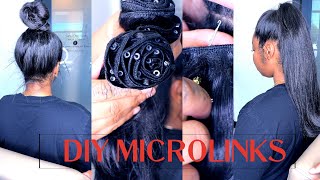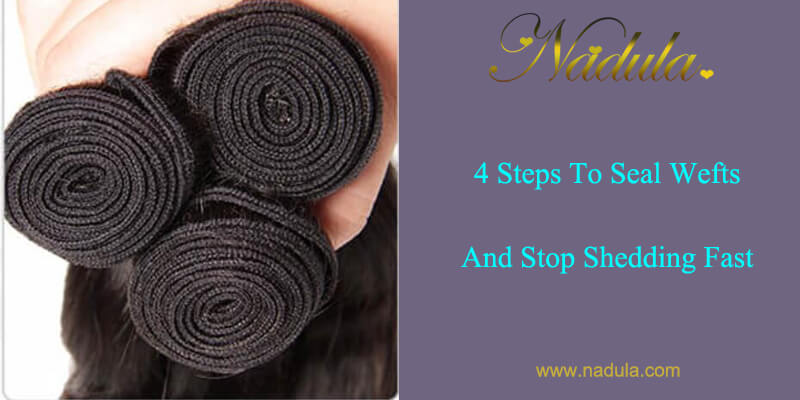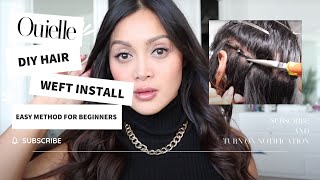Invisible Beaded Weft Tutorial Video
- Posted on 10 September, 2021
- Microlink Hair Extensions
- By Anonymous
In this video, you will be learning how to properly install the invisible beaded weft so starting off before creating your rose, you want to identify the thickness of your client's natural hair, whether it's thin, medium or thick. Knowing that it's thin, it just means that you'll have less rows created and you'll start a little higher above the nape area, knowing that it's typically medium to thick thickness, you will start lower in the nape area and work your way upwards and you have created more Rows ensuring that when you're sectioning on your scalp, your client's scalp for the beaded weft, you are going in a u-shaped form, so we're going to do our same t shape to start. This will just make it easier for us clipping that off to the side again, just making sure it's as neat as possible, just a friendly reminder that mannequins are difficult to section on. So our client here has, i would say, thin to medium hair textures. So we're going to start a little higher just so that when she ties her hair up, it's not visible so starting by the ear you're going to go downwards. To create that! U shape - and this just allows us to ensure that there's full coverage on the sides. As well and that's what will help us when we do that? U shape, rather than just placing it straight and just put a little bit more a little bit more perfect, and then we're going to clip this off. Just making sure your entire process is neat to avoid any complications, so we're going to do the same thing on the other side, following where we sectioned off to create a seamless and connected row and then you're going to flip that off and now you have your First row, so, as you can see, it's not necessarily straight it kind of has that curvature using your alligator clips you're just going to pin that off to the side or to hold all those hairs that are falling. Your next step is to grab your weft um. Just know i am using a lighter weft, so you guys can see my stitching and everything is a little more clear. So typically, your weft will come like this. It comes like very long. I use the machine weft because it is a bit more thicker and more secure and typically what i'll do is i'll measure um, where this is going to go and then i'll do some trimming. So it comes pretty long. So you'll probably end up using both of these and i'll show you guys in a second. So what i'll do is grab the corner piece and i will measure making sure that i'm leaving a two finger space between where the client's perimeter of their face is versus to where i want the weft to begin so, let's say i am starting it over here. I am measuring it on the same side again leaving those two finger spaces so approximately that much so i'm going to trim my weft on this side using some scissors and trimming the weft. So now that i've trimmed my weft and measured it and it looks about right we're going to measure a second one, so you're going to use that extra piece and you're going to measure the second one to be exactly the same length. So then you'll have two wafts at this point. You should have two wefts to match and we will be layering these together and i'll. Show you your next steps, so the next thing you're going to start, which would technically be the first thing that you're going to start is the base of where the wax is going to be stitched through so you're, going to start beading very similar to the way That you apply your nano rings, you're going to start beading using micro beads, which are a little bigger and you're going to start beating an entire row so grabbing your grow links. These are typically 5 0.5 millimeters in width and length so grabbing your loop thread again using your micro links, you're just going to link a few onto your loop so once you've looped, your micro rings, you're, going to start again from the side working your way to The other side, leaving that two-finger space so typically you're gon na do the exact same uh upside down triangular shape that you would do with the nano rings, except you're grabbing, more hair and you're, putting more hair in between the beads, because these beads are a lot. Thicker and more hair can fit in between them and you need that extra support, so you're going to do that triangular upside down triangle, but using a bigger amount of hair, making sure that there's no cross hair is in the way and you're going to do the Same thing, you're going to loop, the hair through the thread, pull that micro ring upwards and onto the hair and bring that a little higher than you would with the nano ring. You will go as close to the root as possible without causing any tension. Then you're going to grab your pliers and you're going to tightly secure, just keep in mind when you are securing the micro ring. You want to secure downwards, not upwards. If you're securing it upwards, then it's going to stick out and you don't want that. You want them to be as invisible as possible, so you're going to make sure that you're clamping them downwards, like so, and then you're going to continue that for the rest of the row, creating that, like upside down triangular form and grabbing a bit more hair looping. Your micro ring onto the hair, pushing it upwards, making sure no crosshairs are in the way and fastening it with your pliers, pointing downwards like so and continuing that on now, if you find that it wasn't tight enough, all you have to do is pinch the sides, These are quite reusable a little more than the nano rings and then just bring it up so once you've finished, applying your micro rings to your row. The first thing you're going to do is one by one: lift them upwards, so you're going to grab all of them and lift up. If you want to grab an extra clip, just hold that up and just hold that up in place making sure all those other hairs are down, so, as you can see, i've just clipped all the rings upwards. The next thing you're going to do is you're going to grab one piece of your weft that we measured and you're going to hold that. Just underneath. Because if there's extra weft here - and it's not close enough to where your last bead is, you will have to trim that off. So we are going to trim a bit more here, but you want to make sure that it's perfectly lined up. So we will have to trim a bit more on the edges here, so once you've made sure that it's all matched up with your micro beads, just gon na make sure that way when you're spreading through it lays flat and there's no extra left sticking out. So that should be good, so you're going to hold this in place grabbing your alligator clips you're just going to clip that with the natural hair. So this will allow it to hold it in place. So typically i'll use two just to keep the other side up. A little bit as well so just hold that upwards and clip, and this will just hold the weft in place for you. The next thing you're going to do is bring those beads down and over and then you're going to grab your second piece of weft, and this is going to go on top, and this is what creates that invisible method where the beads are hidden. There are many ways to creating a weft and doing it. Some people just do the one on top and then start sewing and don't do this one underneath some people do the double sandwich. This just allows for more hair, more coverage and that invisible method. So then, you're going to do the same thing here we will have to trim this one up a little bit so once you trim that and it lines with this one you're going to then clip this one as well. So you're going to this part, gets a little tricky but you're going to let go of one and now you're going to clip on the natural hair and the two wefts, so it holds it in place same thing. On the other side, let go clip on now. Both of the wefts, so now you have both of the wefts held up in place just like so and now it's ready to start the sewing process. So this is going to be your sew in process you're, going to grab your thread and you're going to stretch out both your left and right arm and that's how long your thread is going to be so it's going to be as long as your arms, both Of them fully opened and then you're going to fold it. So once you get reach that you're just going to fold it and you're going to trim this part so once you've trimmed it you're now going to add your needle onto the thread or your thread onto the needle. So once you've got your needle onto your thread. You'Re just going to tie off the two ends and you're going to do just a double knot, so once you've created your double knot, you're just going to trim off these end pieces. So now that you have your needle and thread, you are ready to stitch. So, just making sure that that knot is on the end, so just bringing that downward and you're going to start from left to right or right to left. Whichever way works for you. So the very first thing you're going to start with, especially on your end pieces, are your anchor stitch, and this is basically what holds majority of the weft together. So you're going to start by looping your needle through the client's hair, making sure that you're going through the weft underneath, if you're not going through this weft, then it's not going to be secure and the left behind is going to fall. So you're going to go through the client's hair, that's looped through the bead and then you're going to go through the weft underneath and then up through the left. Over top and you're gon na go you're gon na open your thread and you're gon na go through the thread. That'S opened and you're going to pull, making sure you're always holding on to this thread so that it doesn't get tangled and you're going to pull. Just like so just making sure it's not tangled up and then pull pull, pull all the way and hold that in place. So we'll do that again through the clients, natural hair - that's already looped in the beads, so just over top here, making sure that you're going behind the weft underneath and through the weft over top opening this thread here and going through the thread just like so through The thread so the thread is open, you're going through it and then just pulling and let the thread take its course and keep going making sure that it's tight we're going to do this one more time, a little closer to the edge here to secure this and Making sure that it sticks flat to the client's head so one more time through a little closer to the end here so going through the client's natural hair through both wefts and then through. Your thread like so making sure that these hairs are not playing over top and then pulling that through securing it tightly like so so. This is considered your anchor stitch and this is what holds the sides and the sides are super important. Then you're going to make your way across and you're going to go to your next bead doing the exact same thing: you're going to go through the client's hair, making sure that you're going through that weft underneath, if you're not going through the weft, then it's not Going to be secure - and this time you do not have to put the needle through the um thread you just have to pull just like so you're pulling you're, putting your needle through the actual thread you're, not putting it through the actual thread, you're pulling it through. Just the um sectioning and that will create that stitch, and this is called a blanket stitch. So you're going to do that again through the same bead and same hair and you're going to go behind and then through. Just like so pulling and making sure that that is over top and making sure that it's tight, if you're having those hairs fall, make sure you are clipping them back and then you're moving on to your next piece through the hair, that's through the bead behind the Weft, underneath and through the weft over top and pulling that out, making sure again, you're always holding this to help you and tightening that one more time through that bead through the thread, but not having the thread, separated and then pressing that out. Just like so and continuing on to your next bead through that hair through the left behind and then through the thread here holding onto your thread and it creates that blanket stitch, don't worry if the weft is kind of falling downward. When you tighten up your stitch, it is going to hold it in place and bring it a little higher. So one more time through there making sure that the hair is just kind of out of your way. Sometimes the hair will come in the way, but it's okay. If you want to just pull it out, you can do so like. So i'm just going to fix my weft here and then move along to your next bead, pulling that through both wefts front and back through your thread and the only reason why i'm doing this in a colored thread um. Well, i guess it kind of matches her color, but just so you guys can see it on the left. Okay and just be very careful when you're using the needle. You obviously don't want to pinch the client's scalp so be careful. Now we're going to turn this and keep going through the bead through both wefts come out and over and pull that needle out holding the thread, and do it one more time through the hair through the weft, pulling that needle out creating your stitch. If you need to adjust your weft, sometimes you may do so just pull that one up after moving on to your next through the hair, through the weft, through the thread pulling and tightly fastening, that through the weft through the bead and securing then you're going to Get to your ends again, so you want to make sure that everything is tightly secured. So your last piece is going to be another anchor stitch and it's going to be similar to the one we did in the beginning. So you're just going to loop, your needle through the hair behind the weft, bring that out and you're going to do. The same thing you're going to open up the thread, instead of just normally looping it through you're, going to open up the thread, pull your needle through the opened thread, and this will tightly secure and fasten your weft like so, and then you're going to do that. One more time through and at this point you can just take your clips out through the thread tighten that out. If you want to do one more time, just for more security and just kind of close off this edge here, you can do so through open your thread through the thread. So once you've stitched up your entire head, you want to make sure that these end pieces aren't sticking out too much. So if you need to create another stitch, please do so on those end pieces to ensure that they are not sticking out too much and then what you're going to want to do is you're just going to want to trim this off over here and you're, going To tie a knot after you have cut that off tied your knot, you now are done your first row and typically this is what it will look like. So if you bring the weft upwards, as you can see, it's created that invisible almost like a hairline effect and once you have your stitching and your thread matching the color of the client's hair and the extension, and it all is just like color color blended, then It'Ll all look a lot more seamless and then, when you go to tie it up, it will be hidden and covered next thing. I'M going to show you guys is how to remove and reinstall so for reinstallation, with the invisible beaded method. You can't just pinch the bead and slide it up. So typically the client will come to you and the extensions are all moved down. You will have to remove it all and put it back in. So if you weren't doing the second weft layer, so you were just doing the full row of beads and then putting one weft on top and stitching it. You can just lift the weft upwards, pull those beads down and open them and push them back to the top and then tighten them with your pliers, and then that will literally re-lift the entire thing very quickly. But because we did the invisible method you do have to remove them first, because if we lift this weft up, the beads cannot fall through. So you do have to remove the entire installation and then reinstall so typically being very, very careful you're just going to cut your stitch out and gently start removing it. You may need to cut a few times, i'm just going to remove stitching and then you can start to kind of see. It come off. Obviously, you're going to want to use scissors and be very gentle with this stuff because you don't want to cut the client's hair or cut the weft, so you'll start to see the left kind of come out and you're going to pull your weft out pull your Second, weft out, obviously being as gentle as possible, i'm just going to brush that out, making sure all of your thread is out really ensuring that thread is out and once you've done so all you need to do so. Typically, your client, let's say, for example, is coming to you and the beads are now down to here. All you will have to do is pinch the beads and bring them up so you're just going to open the bead the way you would remove a nano ring. So just open the two sides pinch the sides and bring the bead upwards and tighten it back to the root. If the client has matting and tangle, you will have to remove all of these beads brush those tangles out and then put them back in and start all over. But if their hair looks like it's been properly maintained, all you have to do is pinch that bead and bring it back up so pinch. It open bring it back up and then fasten or if it's matted pinch the sides and remove and then reinstall using a new bead, and that is how you properly install, remove and reinstall your invisible beaded hair extensions.





Comments
K Lloyd: I think you did a better job showing and explaining this then the online certification I paid for. Thanks
Paulina Cervantes: Best tutorial hands down! Easy to understand and straight to the point without taking almost an hour to explain! TY so much for this girly! <3
Kiandrawashere: Thank you so much!! This is the best tutorial on YouTube!! Very detailed and actually shows step by step . Can you please do a video on the invisible weft method without the sew in, just weft and beads. Thank you !
L.: Thank you so much! Great explanation as to how this can be done, from installing to removing or readjusting
Dedee Milnes: You’re so clear and precise thank you so much
Carmen J: Thanks for the information and the video! Can you do a traditional move up and just part the two wefts and loosen and retighten the beads or do you have to completely reinstall each time? Thank you in advance!
Ka_: Thank you so much for the tutorial! Can you fist sew the one beneath and then the one above? Or would that be to much thread in the end?
Lisa Foley: Should you do any extra sewing on the ends so they don’t flip? I’ve heard of people doing an X at the end or thinning out a weft.
Tania Ward: Thank..this was very well shown and explained compared to other videos.
Khairen: Such an informative video. Thank you so much for sharing.
Bianca Aranda: Does the needle go through the inside of the bead where the natural hair goes through?
Kandace: This was a great tutorial! If there’s 2 wefts sandwiched on thin hair will it show a lump thru the hair? Also doesn’t it look like a mullet when you don’t do the sides n very top?
j. chanel: Answer all my questions with one video thank you❤️
Noemi Gaxiola: Your videos are very informative, thanks for that. I was wondering What hair do you recommend for beginners hope to hear from you soon
Dana M: How do u do the sides? Just single beads or also wefts?
Evelin Villazano: What size are the beads you are using ? (:
gladis solis: Can you tell me what kind of thread and beads that is also the needle ? Please
Nina Simone’: How much would you charge for this ?
Beeber Taylor: Awesome tuturial.
Mary Mekwunye: Good job
Danyel Shinkle: Do you see under the bead ?!
Mystic M: Hey Maria, do you work in Bulgaria
Peace Within by Johnsie Hair & Wellness: Great job.